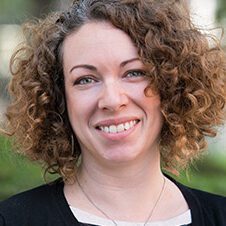Funded by an Investing in Innovation (i3) validation grant from the U.S. Department of Education, SRI conducted an independent evaluation of the Midwest Expansion of the Child-Parent Center (CPC) Program using a quasi-experimental design.
The University of Minnesota, collaborating with four school districts, implemented a revised version of the CPC program. SRI’s evaluation documented implementation of the six program components across the schools in four districts. Overall, the findings demonstrate that most CPC schools implemented the CPC model with good fidelity in the first 2 years. When researchers compared kindergarten outcomes of students in CPC schools to students in comparison schools, they found a consistent positive outcome of the CPC program model on students’ early literacy as measured by standardized assessments. No other significant effects were found at kindergarten entry. Unfortunately, the evaluation team was not able to assess the model’s impact on longer term outcomes of students in second and third grade.
Funded by an Investing in Innovation (i3) validation grant from the U.S. Department of Education, SRI conducted a 5-year independent evaluation of the Midwest Expansion of the Child-Parent Center (CPC) Program using a quasi-experimental design examining impacts on implementation fidelity of program components, students’ school readiness and early academic achievement, and family engagement. The University of Minnesota in collaboration with 4 school districts in the Midwest revised the program model and implemented it in 26 elementary schools or program sites between 2011 and 2016.
Originally implemented in 1967 in response to poor student attendance, low student achievement, and parent disengagement with schools, the CPC Education Program provided comprehensive education and family support services from preschool to third grade (preK–3) to improve children’s school readiness skills and early school achievement and to increase parent engagement in their children’s education and home support for learning.
Beginning in 2012, the University of Minnesota launched the Midwest Expansion project to expand and refine core components of the CPC program in several sites in Illinois, Minnesota, and Wisconsin. The project produced a comprehensive manual that guides school districts or programs on how to implement this preK–3 program. The six program components include: effective learning experiences (with seven requirements related to class size, teacher-child ratios, teacher qualifications and teacher-student interactions); aligned curriculum; continuity and stability; collaborative leadership; parent involvement and engagement; and professional development.
In this evaluation, SRI used a quasi-experimental design which involved following more than 2,000 children from preschool to second grade to track academic and social-emotional outcomes in both the intervention and comparison schools. The two major evaluation questions were as follows:
- Are the CPC intervention components well implemented? (implementation)
- Do students in the CPC Education Program make greater gains in school readiness skills than students in the comparison group? (impact)
The final evaluation report was completed in December 2016 but made available to the public in June 2021. Below we describe the main findings related to implementation of program components and the impacts on student outcomes at kindergarten entry.
Implementation
Overall, the Midwest CPC Expansion components were implemented with fidelity in preschool and kindergarten classrooms for the first 2 years of the project.
- Implementation of the six core components was measured using a variety of tools, including classroom observations, teacher surveys, administrative data, and site visits completed by the implementation team.
- Implementation was strong in both the preschool and kindergarten years of the project across the components.
- However, the comparison sites also implemented several of the requirements as part of preschool and kindergarten classroom business as usual practice, making the distinction between the two conditions similar for some components with the exception of full-day preschool sessions, field trips, classroom quality, and parent involvement in preschool classrooms and teacher-child ratio, instructional plan, assessment/monitoring, classroom quality, program continuity plan, and parent involvement in kindergarten classrooms.
Impact
When we compared kindergarten outcomes, we found a consistent positive outcome of the CPC program model on early literacy as measured by Woodcock-Johnson Tests of Achievement Letter-Word Identification although not statistically significant for the overall sample.
- No other significant effects were found.
- We were not able to assess the impact on longer term outcomes in second and third grade.
- Exploratory analyses found better outcomes for children who started CPC preschool as 3-year-olds and received 2 years of preschool—compared to children who had 1 year of CPC preschool and compared to children who received 2 years of comparison preschool. There were no differences between children who participated in full-day preschool versus half-day preschool in any of our analyses.
The final report presents the limitations of the study, including why testing the full P-3 model did not occur and how the comparison group classrooms and schools had many of the quality features of the CPC model schools and classrooms. In conclusion, this evaluation contributes important new information about the revised and updated CPC model (referred to here as the Midwest CPC Expansion project), but it does not go far enough in shedding light on the theoretical benefits of the CPC model as a contemporary alternative to other preschool programs that are currently implemented across the country.
Although preschool programs and funding have increased in recent decades, with many young children receiving the extra support needed to prepare them to be successful when they enter kindergarten, policy-level challenges remain. There is a tension in the early childhood field about how best to both increase access to early care and education experiences and improve the quality of those experiences. To attain the promise of early education programs, including preschool alone as well as P-3 models, the field has an urgent need to find the most cost-effective models to close the school preparation and achievement gaps that persist and for which solutions continue to be elusive. Comprehensive P-3 models such as the CPC model offer to fill that need, but the results of this evaluation do not provide unequivocal support for its unique quality or benefits.
The views and conclusions contained herein are those of the author is and should not be interpreted as necessarily representing the official policies or endorsements, either expressed or implied, of the USDE or the U.S. Government.
This evaluation project conducted by SRI International (under Contract No. U411B110098) was funded in whole or in part with Federal funds from the Education Innovation and Research program under the U.S. Department of Education’s Office of Elementary and Secondary Education (OESE) (formerly Investing in Innovation grant – i3 grant). The total funding for this i3 grant was $14,999,766. SRI’s Subaward (A002619801) with the University of Minnesota was for a total of $2,063,575.
Associated fields of research
Associated SRI team members
-

Erika Gaylor
Principal Senior Researcher and Early Childhood Program Leader, SRI Education
-

Kate Ferguson
Project Administrator, SRI Education
-

Betsy Davies-Mercier
Senior Researcher, SRI Education



